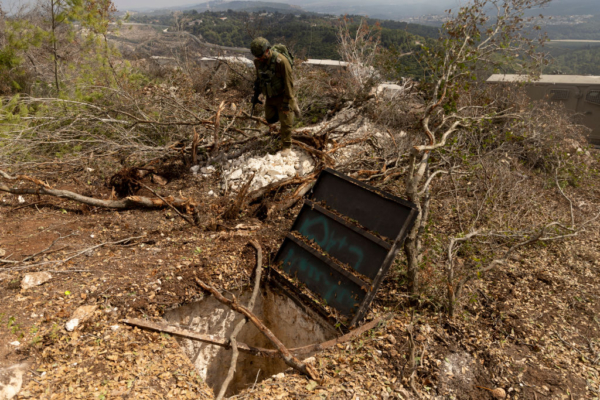Israel’s military has announced that in recent weeks, during operations in southern Lebanon, they have discovered Hezbollah’s underground tunnel network, including weapon depots and rocket launch systems. These military facilities pose a direct threat to nearby communities.
Last year on October 7th, a terrorist attack by Hamas on Israel sparked the Gaza War. The Israeli military stated that the ground operations in southern Lebanon are aimed at preventing Hezbollah from launching similar attacks on the northern border of Israel.
According to reports from Reuters, over the past year, the Israeli military has focused on destroying Hamas’s extensive underground network in Gaza. Now, their focus is on dismantling Hezbollah extremists’ tunnels and other hiding places in southern Lebanon.
Since entering combat in southern Lebanon this month, the Israeli military has uncovered Hezbollah’s underground attack capabilities, most notably the tunnel systems with weapon depots and rocket launchers.
Political analyst Eva J. Koulouriotis, who specializes in the Middle East and radical organizations, mentioned that in southern Lebanon, many residents view the fully armed Hezbollah as “defenders” of the territory, allowing Hezbollah to establish military infrastructure within villages.
The Israeli military has found Hezbollah weapons inside homes and buildings in the villages.
Koulouriotis mentioned that Hezbollah tunnels extend underground to the southern suburbs of Beirut, storing a stockpile of strategic missiles. The organization’s command and control center is located there. She added that they also have tunnels along the border with Syria, used for smuggling Iranian weapons and other supplies into Lebanon.
Additionally, Hezbollah stores missile tunnels in southern Lebanon, where they also launch missiles. Some of the more than fifty Israelis killed by Hezbollah over the past year were hit by anti-tank missiles.
Unlike the tunnels Hamas dug in Gaza’s coastal sand, Hezbollah’s tunnels in southern Lebanon are carved out of hard rock, requiring time, money, machinery, and expertise.
Experts suggest that Hezbollah’s tunnel system is not limited to southern Lebanon. Tal Beeri, an expert on Hezbollah from the Alma Research and Education Center focused on Israel’s security in the north, stated, “The land is full of underground tunnels.”
An Israeli military official stated that based on previous intelligence, Israel has discovered “hundreds” of Hezbollah underground armed positions, many of which can accommodate about ten fighters and contain supplies.
Back in 2006, during a month-long war between Hezbollah and Israel, tunnel warfare was utilized. A ceasefire was reached in August of the same year. Under UN Resolution 1701, Lebanon and UN forces are stationed in southern Lebanon, and Hezbollah militants must withdraw from the area. However, Hezbollah’s underground network continues to expand in the region.
In mid-August of this year, a video published by Hezbollah displayed an underground tunnel that looked like a cave but was spacious enough to accommodate a truck carrying missiles. The tunnel was named Imad-4 after the late military commander Imad Mughniyeh, who died in a 2008 explosion in Syria.
Israel is pressing forward with a ground offensive in southern Lebanon using tanks and engineering equipment. Since the beginning of the month, the Israeli Air Force and ground forces have targeted thousands of objectives in the area.
Recently, the Israeli military revealed they had found a cross-border tunnel that only extended a few meters into Israeli territory without an exit. They also discovered a vertical shaft tunnel about 100 meters from a UN peacekeeping outpost; the exact purpose of this tunnel remains unclear.
These tunnels contain supplies and weapons, equipped with lighting, ventilation systems, and sometimes water pipes, indicating they are intended for long-term use.
The Israeli military has arrested several Hezbollah militants hiding in the tunnels, including three armed Hezbollah extremists discovered on Tuesday.
Israeli military officials suggest that many Hezbollah militants seem to have evacuated the area.
Estimations from Lebanese military expert and retired Brigadier General Naji Malaeb suggest that Hezbollah’s tunnels could hamper Israeli ground operations. He believes this resistance is reminiscent of what Israel encountered during the Gaza War, where Hamas employed tunnels for guerrilla warfare.
Prior to this, Israel had encountered tunnel warfare from Hezbollah. In 2018, Israel destroyed Hezbollah’s cross-border tunnels. Tal Beeri mentioned that at the time, the Israeli military found six tunnels, one of which was 1 kilometer long, 80 meters deep, and crossed about 50 meters into Israeli territory.
Israel believes that Hezbollah is planning a massacre reminiscent of the “October 7th Terror Attack.” These underground tunnels serve as evidence of Hezbollah’s plans to launch similar attacks in northern Israel.
Israel Defense Forces spokesperson Daniel Hagari stated on the day Israeli ground forces entered Lebanon, “Hezbollah openly declared intentions to carry out their version of the ‘October 7th Terror Attack’ in northern Israel, potentially on a larger scale.”
Former Hezbollah leader Hassan Nasrallah was killed by the Israeli military last month. He had previously indicated the possibility of an attack on northern Israel.
In May 2023, a few months before Hamas launched the “October 7th Terror Attack,” Hezbollah simulated an invasion scenario in northern Israel: a group of radical individuals on motorcycles, armed with rifles, breached the border filled with Israeli flags, entering Israel. Hezbollah officials often frame attacks on Israel as defensive measures.
On October 8th last year, the day after Hamas’s “October 7th Terror Attack,” Hezbollah began firing rockets at Israel, leading to ongoing clashes between the two sides for over a year.
On October 1st this year, Israel sent thousands of ground troops into southern Lebanon to combat Hezbollah. While reinforcements continue, Israel describes the invasion of southern Lebanon as a “limited, localized, and targeted ground assault” aimed at destroying Hezbollah’s military infrastructure and allowing tens of thousands of displaced Israelis to return home.
Over the past month, over a million Lebanese people have been displaced to escape the ongoing conflict.

